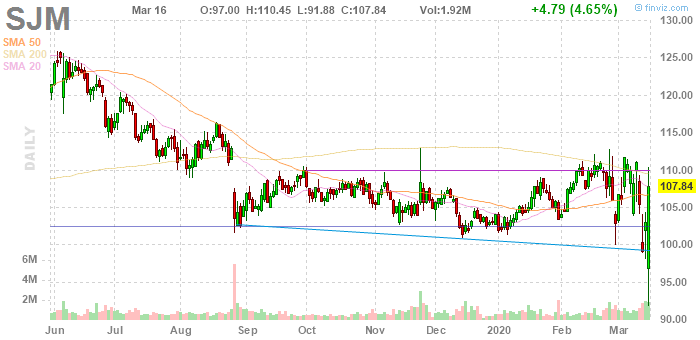Since Feb. 19, the S&P 500 has lost almost exactly 1,000 points. It’s fallen nearly 30% over that stretch. The NASDAQ Composite has seen the same decline on a percentage basis. The Dow Jones Industrial Average is down more than 6,000 points, or 21%.
Trillions of dollars in valuation have been erased. After indices fell on average over 12% on Monday, it has become increasingly clear that the sell-off in U.S. stocks is being driven by far more than just short-term factors. At this point, equities have priced in the increasingly likely short-term shutdown in the economy and then some.
It’s true that impacted sectors have been absolutely hammered. Energy stocks have plunged, though the price war begun by Saudi Arabia is an important factor. Airline stocks have been crushed. Casino stocks, somewhat quietly, have done even worse.
But even stocks with seemingly minimal short-term impact have seen declines. That might be panic selling. It might be the result of a bull market that simply ran too far.
Tuesday’s big stock charts feature three names whose businesses should at worst survive a recession. All three still are holding on, if tenuously, to longer-term support levels. Their recent declines show how far-reaching the sell-off has been. Their charts might make them opportunities for investors who believe that, finally, the worst may be behind us.
Johnson & Johnson (JNJ)
As bad as it was for Johnson & Johnson (NYSE:JNJ) on Monday, with JNJ stock declining over 5%, it could have been worse. And the first of Tuesday’s big stock charts suggests it could get better going forward:
- In the context of a double-digit broad market sell-off, a 5% loss is not that bad. And though JNJ has dipped below long-term support, it closed back at that key level on Monday. In this market, it’s probably too early to call the bottom in any stock, and shares did fade late in the session. Still, at the least JNJ is starting to stabilize, which is a step in the right direction.
- There’s still a lot of work left to do, admittedly. Risks persist. The company only recently seemed to overcome legal issues relating to its talcum powder and opioid products, which could return. Secular pressure will remain on the consumer business, and the long-term health of the pharmaceutical industry as a whole remains unclear. JNJ stock is cheap, and a 3% dividend yield helps the case, but it still needs to drive long-term growth for the stock to deliver upside.
- Still, for investors looking to dip a toe back into this market, Johnson & Johnson stock at least is intriguing. I argued early last month that JNJ was a safe place for investors to hide out. That advice unfortunately has proven to be incorrect in the short term. There’s still a chance it will pay off over the long haul.
J.M. Smucker (SJM)
One of the few bright spots on Monday was the consumer processed goods space, which saw several stocks rally. J.M. Smucker (NYSE:SJM) was one of those stocks. And after the gains, the second of our big stock charts looks surprisingly normal:
- Here, too, support has held, but for a second time after SJM found a bottom in late February. Excluding selling pressure in recent sessions, this is a stock that’s traded in a tight range going back to September. That’s not necessarily good news — support still could give way — but sideways trading in this flailing market obviously is nothing to sneeze at.
- Again, SJM wasn’t alone in rallying. Conagra Brands (NYSE:CAG) gained almost 10%. Hormel Foods (NYSE:HRL) and Campbell Soup (NYSE:CPB) closed modestly in the green. And it’s not hard to see why. U.S. consumers are stocking up. The sector wasn’t expensive to begin with; in fact, all four of these names (excepting, to some extent, HRL) largely missed out on the market rally of the past few years.
- As panicked as the market seems to be, investors at least were able to see some value in a sector that could see a near-term tailwind. Going forward, that might bode well for SJM stock, whose transition to growth categories like pet food and coffee I’ve long supported. In fact, it might bode well for the entire sector.
Zscaler (ZS)
Cloud security company Zscaler (NASDAQ:ZS) shouldn’t see an enormous impact from the spread of the coronavirus. Revenue no doubt will be delayed as offices close. A recession could have a moderate short-term effect.
Yet, like many growth stocks, ZS stock isn’t pricing in near-term earnings to begin with. It’s a play on profits in the second half of this decade and beyond. In that context, the third of Tuesday’s big stock charts is interesting for the market as a whole:
- ZS stock has found a bit of a bottom. Shares rallied 6% on Friday and held that level on Monday. A Wedbush note on Monday that backed the stock might have helped, though it did little for larger names like Microsoft (NASDAQ:MSFT) and Apple (NASDAQ:AAPL).
- Here, too, there’s a lot of work left to do. It’s possible the rally is a “dead cat bounce.” ZS stock still isn’t cheap, or close, trading at over 200x 2020 consensus earnings per share estimates and about 13x guidance for fiscal 2020 (ending June) revenue.
- Again, it seems increasingly clear that this broad sell-off is driven at least in part by valuation fears. And so ZS stock is an interesting test case. Do investors focus on the still-high valuation or the discount created by the recent sell-off? At least on Monday, they chose the latter, which might bode well for the market going forward.
Vince Martin has covered the financial industry for close to a decade for InvestorPlace.com and other outlets. He has no positions in any securities mentioned.



